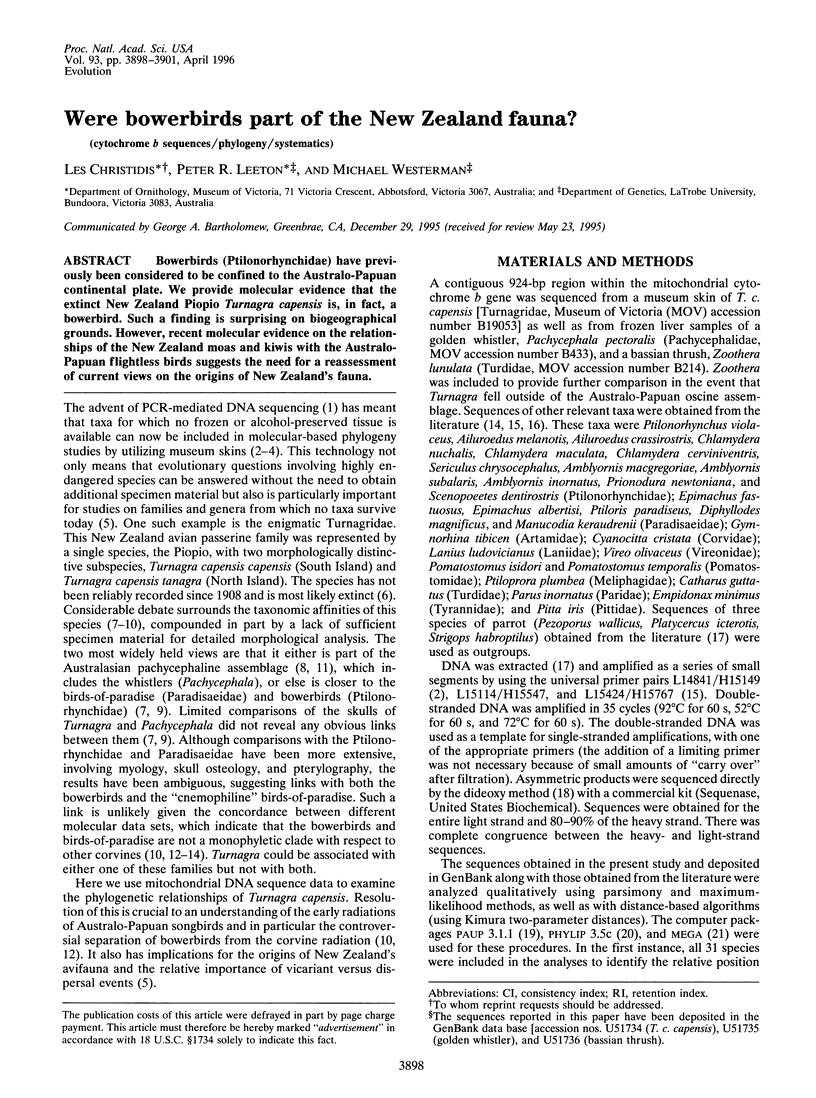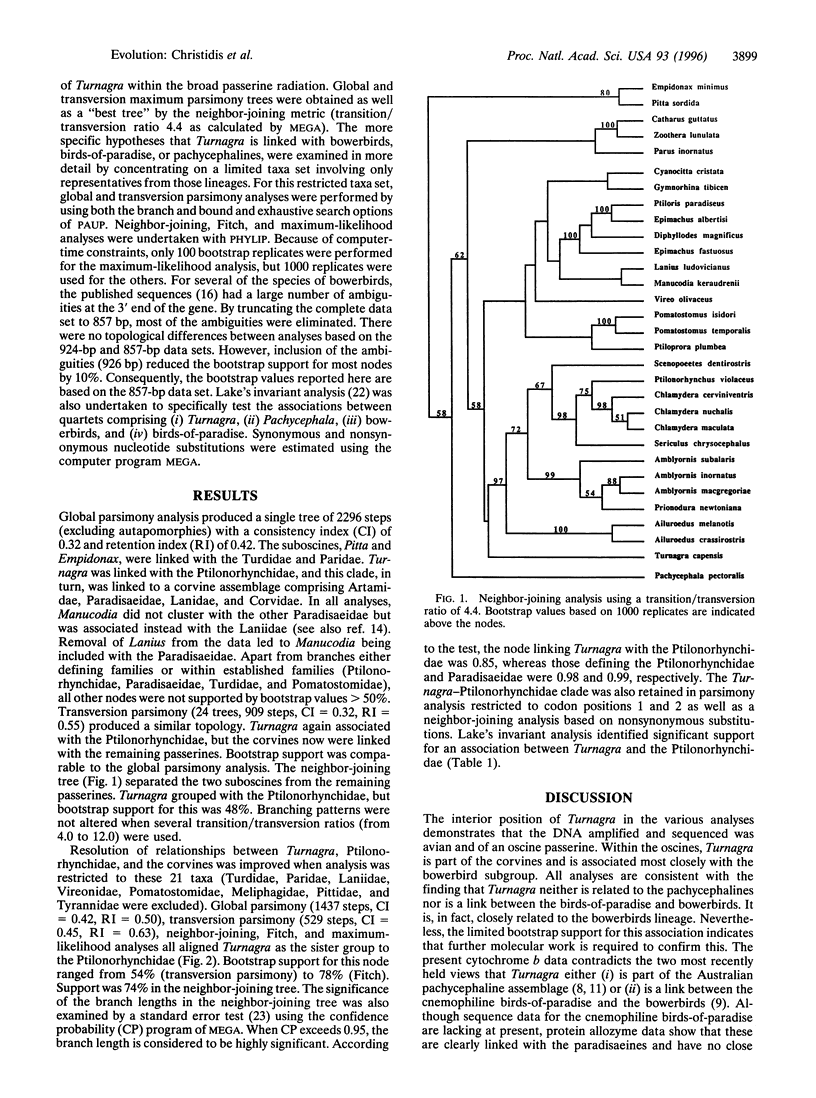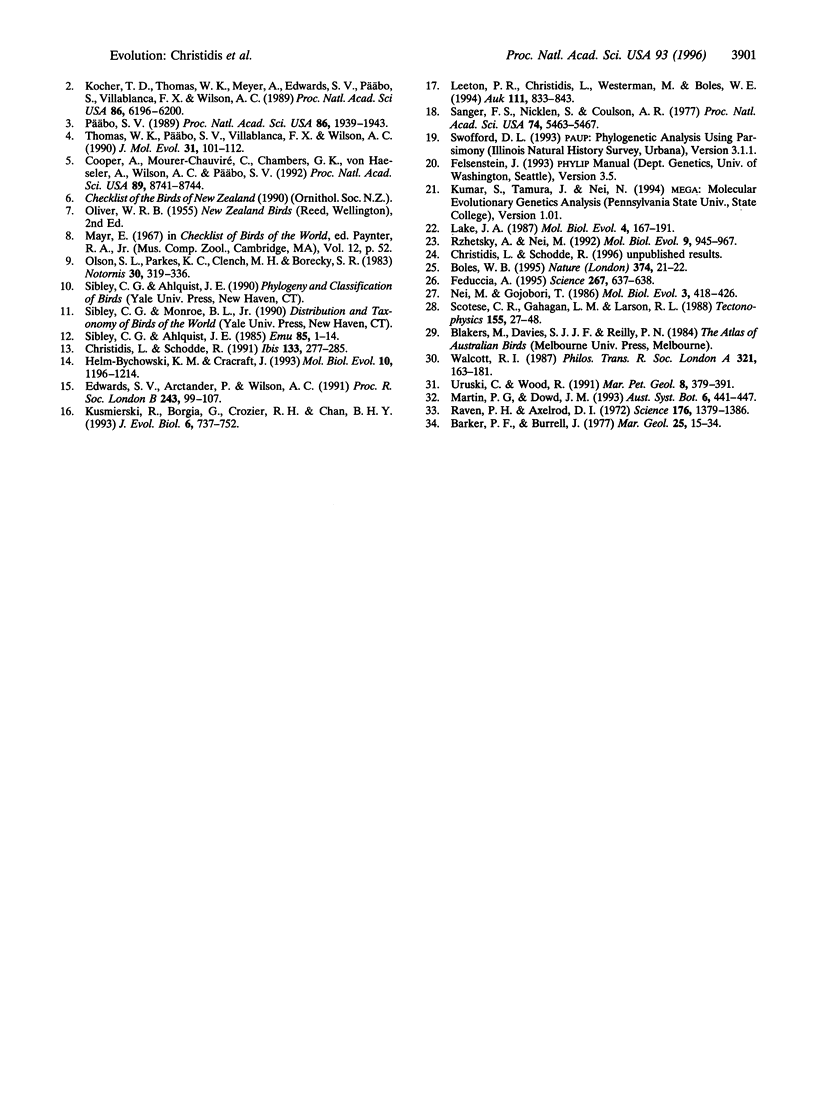Abstract
Bowerbirds (Ptilonorhynchidae) have previously been considered to be confined to the Australo-Papuan continental plate. We provide molecular evidence that the extinct New Zealand Piopio Turnagra capensis is, in fact, a bowerbird. Such a finding is surprising on biogeographical grounds. However, recent molecular evidence on the relationships of the New Zealand moas and kiwis with the Australo-Papuan flightless birds suggests the need for a reassessment of current views on the origins of New Zealand's fauna.
Full text
PDF



Selected References
These references are in PubMed. This may not be the complete list of references from this article.
- Cooper A., Mourer-Chauviré C., Chambers G. K., von Haeseler A., Wilson A. C., Päbo S. Independent origins of New Zealand moas and kiwis. Proc Natl Acad Sci U S A. 1992 Sep 15;89(18):8741–8744. doi: 10.1073/pnas.89.18.8741. [DOI] [PMC free article] [PubMed] [Google Scholar]
- Edwards S. V., Arctander P., Wilson A. C. Mitochondrial resolution of a deep branch in the genealogical tree for perching birds. Proc Biol Sci. 1991 Feb 22;243(1307):99–107. doi: 10.1098/rspb.1991.0017. [DOI] [PubMed] [Google Scholar]
- Feduccia A. Explosive evolution in tertiary birds and mammals. Science. 1995 Feb 3;267(5198):637–638. doi: 10.1126/science.267.5198.637. [DOI] [PubMed] [Google Scholar]
- Helm-Bychowski K., Cracraft J. Recovering phylogenetic signal from DNA sequences: relationships within the corvine assemblage (class aves) as inferred from complete sequences of the mitochondrial DNA cytochrome-b gene. Mol Biol Evol. 1993 Nov;10(6):1196–1214. doi: 10.1093/oxfordjournals.molbev.a040072. [DOI] [PubMed] [Google Scholar]
- Kocher T. D., Thomas W. K., Meyer A., Edwards S. V., Päbo S., Villablanca F. X., Wilson A. C. Dynamics of mitochondrial DNA evolution in animals: amplification and sequencing with conserved primers. Proc Natl Acad Sci U S A. 1989 Aug;86(16):6196–6200. doi: 10.1073/pnas.86.16.6196. [DOI] [PMC free article] [PubMed] [Google Scholar]
- Lake J. A. A rate-independent technique for analysis of nucleic acid sequences: evolutionary parsimony. Mol Biol Evol. 1987 Mar;4(2):167–191. doi: 10.1093/oxfordjournals.molbev.a040433. [DOI] [PubMed] [Google Scholar]
- Nei M., Gojobori T. Simple methods for estimating the numbers of synonymous and nonsynonymous nucleotide substitutions. Mol Biol Evol. 1986 Sep;3(5):418–426. doi: 10.1093/oxfordjournals.molbev.a040410. [DOI] [PubMed] [Google Scholar]
- Päbo S. Ancient DNA: extraction, characterization, molecular cloning, and enzymatic amplification. Proc Natl Acad Sci U S A. 1989 Mar;86(6):1939–1943. doi: 10.1073/pnas.86.6.1939. [DOI] [PMC free article] [PubMed] [Google Scholar]
- Raven P. H., Axc Arod D. I. Plate tectonics and australasian paleobiogeography. Science. 1972 Jun 30;176(4042):1379–1386. doi: 10.1126/science.176.4042.1379. [DOI] [PubMed] [Google Scholar]
- Saiki R. K., Gelfand D. H., Stoffel S., Scharf S. J., Higuchi R., Horn G. T., Mullis K. B., Erlich H. A. Primer-directed enzymatic amplification of DNA with a thermostable DNA polymerase. Science. 1988 Jan 29;239(4839):487–491. doi: 10.1126/science.2448875. [DOI] [PubMed] [Google Scholar]
- Sanger F., Nicklen S., Coulson A. R. DNA sequencing with chain-terminating inhibitors. Proc Natl Acad Sci U S A. 1977 Dec;74(12):5463–5467. doi: 10.1073/pnas.74.12.5463. [DOI] [PMC free article] [PubMed] [Google Scholar]
- Thomas W. K., Päbo S., Villablanca F. X., Wilson A. C. Spatial and temporal continuity of kangaroo rat populations shown by sequencing mitochondrial DNA from museum specimens. J Mol Evol. 1990 Aug;31(2):101–112. doi: 10.1007/BF02109479. [DOI] [PubMed] [Google Scholar]


